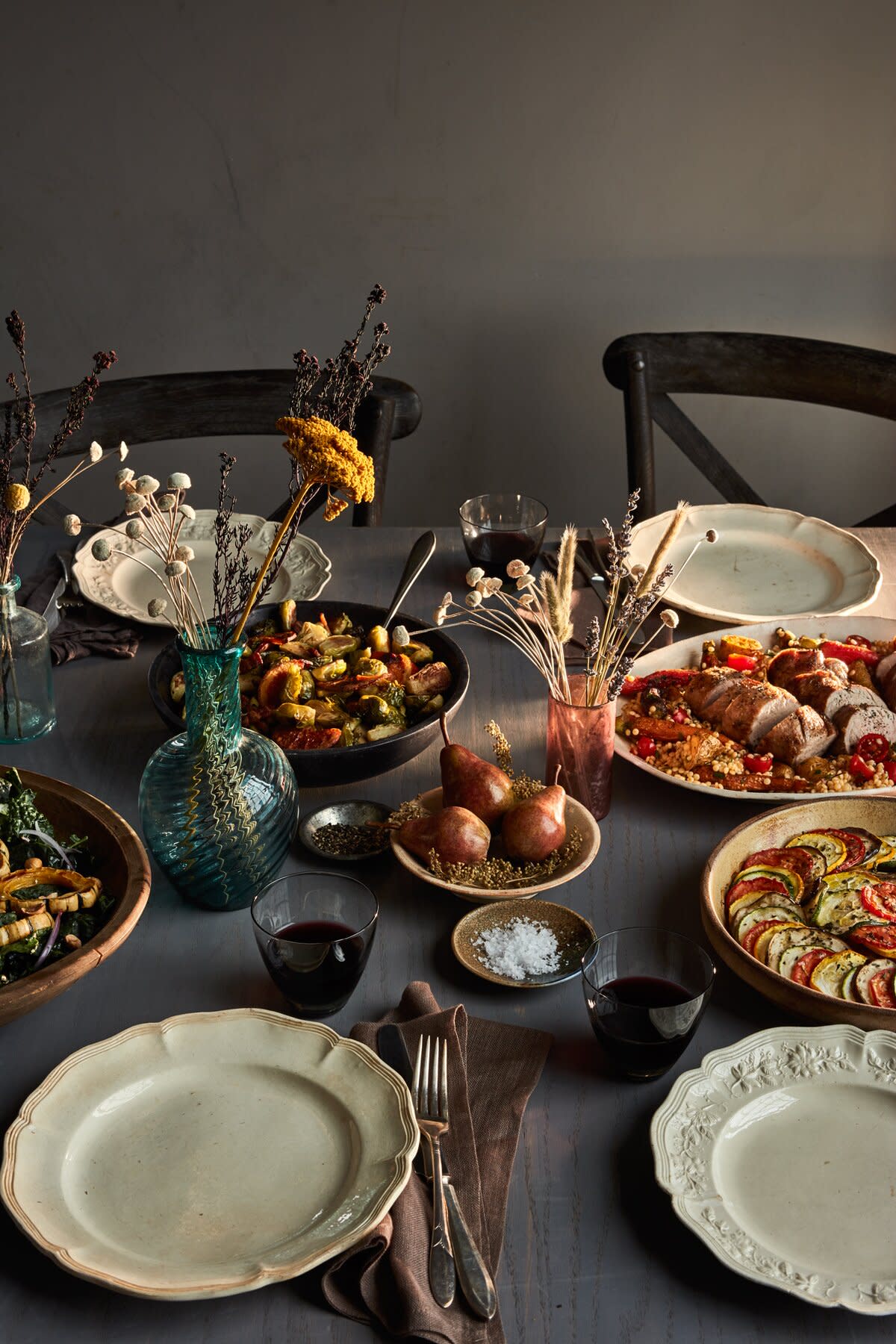Your Guide to Creating a Deliciously Balanced Menu for Your Next Dinner Party

Justin Walker
Orchestrating a meal is just that: It's a carefully composed combination of ingredients, textures, and flavors that come together to create wonderful new memories. Some dishes have the power to transport your loved ones to other places, while others feel nostalgic and evoke feelings family traditions, vacations, or other relatives. There are many details that can go into making a dinner party one for the books, but planning the menu is the most important. Still, it doesn't have to be stressful. If you keep a few things in mind, it really becomes a simple formula, and your gatherings can be low-stress while still being an evening guests will talk about long after the meal is over. Brush up on this wisdom now and plan to entertain again as soon as it's safe to do so.
Related: A Make-Ahead Dinner Party Menu for a Cozy Meal
Getting Started
Having a simple pre-made cocktail or a bottle of wine open and a few snacks, like warm olives, roasted nuts, or an elegant monochromatic crudité platter, ready when guests arrive is a casual and stress-free approach to appetizers; drinks and snacks at the ready will also get conversations going, which gives you time finish up any last-minute details in the kitchen or at the table.
Plan Seasonally
There is no better way to find inspiration and to keep your menus feeling fresh than planning a dinner based on what produce is in season. Visit a local farmers' market if you can, or see if you can have a CSA box of produce delivered. Check out a guide to what to look for based by month, and check out our seasonal recipes.
Texture, Flavor, and Color
Texture is a crucial element in individual dishes, and when you are thinking about an entire meal, it is even more essential to make sure you have variety. Try not to double up on rich and creamy dishes or starches, and offer both cooked and raw vegetable sides or salads.
From the bottle of wine you plan to open to the dessert that will end the evening, consider how all the flavors will work together. Avoid repeating flavors, like having both a main course and a dessert with lemon. If there is something sweet, try to find something more salty or bitter to accompany it (like combining olives and raisins) and vice-versa. Also be careful that everything is not too spicy, and if using ingredients with a lot of heat, go light, unless you know your guests tastes well. This doesn't mean you need to shy away from bold flavors, it is really about creating balance, and considering how different flavors compliment each other. If you're curious to learn more, The Flavor Bible ($26.99, amazon.com) is an incredible guide to pairing flavors.
Impressing guests also has so much to do with presentation. By incorporating fresh, seasonal produce into your meal, you are also welcoming a mix of colors that can make the table more appealing to the eye. A spread of all roasted brown foods or pale, creamy foods may taste good but vibrant vegetables, greens, fruits, and fresh herbs can make even a simple dish wow your guests.
Keep It Simple
When choosing a main dish, keep it simple. It can be stressful trying out a new, or overly complicated recipe when expecting company or celebrating a special occasion, often times it's the recipes that you have really mastered that will be the most delicious like that Perfect Roast Chicken. When served with a variety of sides and salads, the main dish doesn't always need to be a showstopper. If something can be made ahead so there is less to stress about right before guests arrive, you'll save yourself from frantically frying or trying to clean up a big mess.
At the Table
Consider how you will be serving dishes. Portions, whether plated, or served buffet-style, should be as easy as possible for guests to eat. Carving anything at the table can be awkward and messy; food should be carved or sliced before bringing to the table. Dishes that are pre-portioned, such as fish filets and scallops, chicken breasts or thighs, pork chops, lamb shanks, or larger sliceable dishes such as brisket are even easier. For a plant-based entrée consider stuffed acorn squash. Cornish game hens are a great alternative to whole chickens—cut in half, each guest gets both white and dark meat with much less effort. Eating with your hands is great for casual get togethers or barbecues and is perfectly fine for homemade pizza, but messy difficult-to-eat choices like ribs should be avoided.
On the Side
Think seasonal and complement rather than echo the flavors of your main dish with a colorful roasted vegetable side, stovetop dishes, or a bright and unexpected winter salad like one with shaved butternut squash, carrots, and dates or with persimmons, beets, and citrus.
The Sweet Stuff
Sometimes a heavy, sweet dessert at the end of a meal is really gilding the lily, and all you need is a little bite will satisfy everyone's sweet tooth. On the other hand, if you're preparing a really simple main dish, an over-the-top dessert will be a real surprise and a great finale but always aim to have your guests leave satisfied and not stuffed. If you love to bake, bake something you can make in advance. If you don't, maybe just have store-bought sorbets in different flavors on hand or a selection of really good chocolate. Something simple to take home, like a cookie or brownie, is great when company doesn't have room for dessert or to send home for someone who couldn't make it to dinner. And dessert is also another great place to showcase seasonal fruit in pies, bars, cakes, and crisps, and is also an opportunity to introduce surprising, bold, or luxurious flavors.

